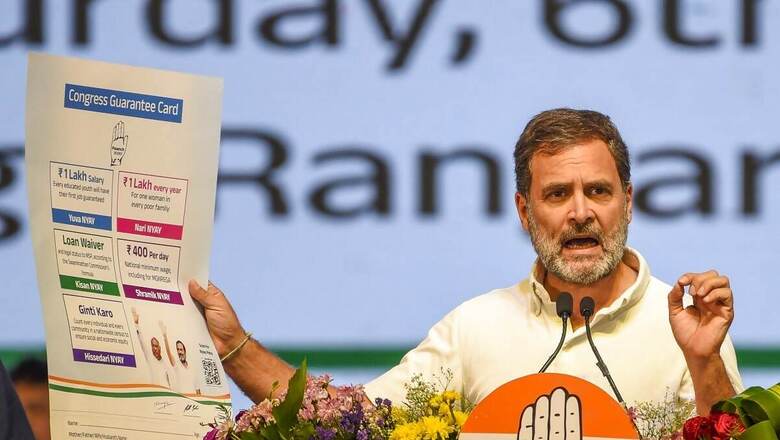
views
Congress party’s proclaimed “mentors” Messrs Sam Pitroda and Kaushik Basu know more than they are letting on. Their flurry of financially retrograde statements advocating for “bolshewokeist” taxes are not mere musings. These statements, made around the time the Congress released its 2024 vision statement, betray real compulsions that originate from the grand old party’s manifesto.
Pitroda and Basu realise money will have to be raised by the bucketfuls to fund the promises made by the Congress in its electoral mission statement.
Let’s take the Mahalakshmi scheme which offers to provide Rs 1 lakh per year to every poor Indian family as an unconditional cash transfer. The amount will be directly transferred to the bank account of the oldest woman of the poorest households.
This is a Sisyphean undertaking. Tellingly the manifesto doesn’t reveal the exact number of poor families the Congress seeks to reach under its Mahalakshmi welfare scheme. Is this because it doesn’t want anyone to estimate how much such a megalithic scheme will cost?
Unfortunately, in India, data has become weaponised. It is a subset of politics. Poverty estimates vary wildly. NITI Aayog’s Multidimensional Poverty Index pegs the poverty ratio at around 11 per cent. But it could also be as low as 5 per cent if one considers the latest data from the Government of India’s consumption expenditure survey. Then again, the Tendulkar Committee estimates that 25.7 per cent of the rural population and 13.7 per cent of the urban population live in poverty.
But despite these shifting poverty baselines, it is yet possible to estimate how much the Mahalakshmi scheme will cost. Essentially the scheme is an upgraded version of the Nyuntam Aay Yojana (NYAY) scheme that the Congress had vowed to implement in 2019 if voted to power. At the time, the Congress was considering an unconditional cash transfer of Rs 72,000 a year to the poorest 20 per cent of all Indian families (roughly 5 crore households). So, if the Congress party decides to dole out Rs 1 lakh per year to the eldest woman member of every household in the bottom 20 per cent of the Indian population, then implementing the Mahalakshmi scheme will cost taxpayers Rs 6 lakh crore per annum. To give you an idea, this massive recurring yearly expense is more than India’s current total expenditure on PDS and Farm subsidies taken together.
Talking about handing out cash, the Congress manifesto additionally proposes to “double wages” under MNREGA to Rs 400 per day for a minimum of 100 days. At present, the average allowance under MNREGA to each recipient is set at Rs 289 per day. “Doubling” the payout will push up the total budgetary allocation for MNREGA to about 1.80 lakh crore. An allocation of Rs 1.80 lakh crore at around 1 per cent of GDP is almost double of India’s annual health expenditure for 2025.
Now, let’s consider the Congress promise of passing a legislation guaranteeing Minimum Support Price (MSP) fixed at C2 (actual cost) + 50 per cent. This is in line with the Swaminathan Committee’s recommendation that the Congress wholeheartedly backs. The Union government has estimated that such a law guaranteeing MSP fixed to C2 + 50 per cent would force the government to buy all crops produced in the country at a prohibitive Rs 10 lakh crore per annum. Some have however rubbished this number rejecting the notion that the Centre will be obliged to purchase all crops produced across the country. But legal experts disagree. Creating a reasonable classification, excluding certain crops, could spell legal problems. How, for instance, can the government justify excluding subsidence farmers growing vegetables from the ambit of the MSP law?
To put things in perspective, an annual expenditure of Rs 10 lakh crore is more than the annual average expenditure the government has undertaken in infrastructure in the last seven fiscal years (Rs 67 lakh crore, between 2016 and 2023).
High on the Congress party’s list of manifesto priorities is the Right To Apprenticeship Act. This is touted as the world’s first-of-its-kind skilling programme. The law guarantees a one-year apprenticeship to graduates and diploma holders in a private or PSU company. Under the Act, each apprentice will be mandatorily paid a Rs 1 lakh stipend annually. Such a scheme calculated on the number of graduates and diploma holders completing their course each year will cost the taxpayer approximately 1 lakh crore. This number is around a sixth of India’s total budgetary defence outlay for FY 2025.
There is also another less-noticed ticking financial time bomb. The promise of an education loan waiver. This alone is estimated to cost the exchequer Rs 1 lakh crore.
These are just some of the bigger welfare schemes the Congress has promised to implement if voted to office. But there are several other unconditional bursaries that will need budgetary support. The Congress has also vowed to carry out an unspecified number of socio-economic and caste surveys. These are very expensive by themselves.
Aside from the practical difficulty of funding these schemes without resorting to levying stiff cesses and taxes (which will trigger inflation and restrictive monetary policies), these model schemes are also highly patronising of the have-nots. But perhaps most importantly, such schemes absolve any prospective Congress government of any moral obligation towards creating meaningful jobs.
Clearly, a populist Congress looking for the shortest route to power has decided to skip the stairs and take the elevator instead.
Views expressed in the above piece are personal and solely that of the author. They do not necessarily reflect News18’s views.




















Comments
0 comment